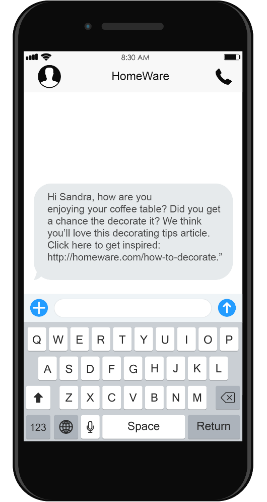
Remarkably, 46% of people spent around 5-6 hours per day on their phones.
And they’re not spending their time exclusively on social media. By 2024, 85% of all e-commerce sales will be mobile.
These days, multiple online brands and the rise of new communication channels make it challenging for small businesses to stand out. And if you’re starting a new business, you’re facing an uphill battle to catch up with established businesses.
However, this doesn’t mean that small business owners and marketers are helpless. But, to stand out and accelerate business growth, you must experiment with and embrace new marketing channels.
SMS marketing can help many small businesses.
What is SMS marketing?
SMS marketing sends campaigns, promotions, news, and updates to customers and prospects via text messages.

SMS (short message service) marketing is an underrated channel in marketing strategy, but its strength lies in its ability to engage target customers in a non-intrusive and more personalized manner.
If you’re looking to expand your small business marketing strategies, this is the ultimate small business guide to SMS marketing.
Ultimate Guide to SMS Marketing

But first, what is SMS?
SMS stands for short message service. It is also known as text messaging.
SMS messaging is a technique that uses texting to inform consumers about anything the small business wants them to know. This form of communication allows messages to be sent en masse to recipients who voluntarily provided their numbers.
SMS marketing can be a one-on-one text conversation between customers and customer service representatives or automated messages triggered by a customer’s action.
For example, a business may send a text message with shipping confirmation after a customer purchases.
Types of SMS marketing techniques
Text campaigns
Text or SMS campaigns are most commonly used for sales and promotions.
This tactic is used primarily because it is presumed that almost everyone has a mobile phone that they most likely check more than once a day. A study by Deloitte reveals that an average American checks their phone at least 46 times a day.
With a text or SMS campaign, small businesses can send information to a larger group of customers or prospects.
SMS messages and campaigns have an average of 98% open and a response rate of 46%! This comes as no surprise. SMS campaign messages have these high effectiveness rates because their format usually comes with a sense of urgency.
Text campaigns typically inform a customer about a limited-time offer. And should the customer be interested, they have to act quickly and immediately take action.
Text campaigns have high success rates because of how people use mobile phones. A recent report found that 78% of consumers say that checking, sending, and answering text messages is the activity they do most on their smartphones. And, almost 60% of texts are read within 1 to 3 minutes, whereas emails or regular mail could potentially never be opened.

Transactional text campaigns
Transactional SMS is a text message sent to consumers to help them along their customer journey.
A transactional SMS helps address customers’ pain points – when they have questions, they want answers immediately.
A transactional SMS can be a way for your small business to provide solutions promptly. After all, nothing is more disgruntling to a customer than needing help with an issue and feeling like they have to wait forever for a response.
Transactional text messages can help improve the customer experience.
Main benefits of SMS marketing for small businesses
SMS marketing is more personal
What’s the first thing people do when they wake up? It’s probably not surprising that most of them reach for their phones. 74% of people do this as a daily habit.
So when a customer opts in and shares their mobile number with your business, this opens a connection that allows direct, immediate, and one-on-one conversations with them.
SMS marketing is easy to track
Because SMS marketing is permission-based, you’re off to an excellent start. For one, you will not come across as intrusive or overstepping on your customers’ privacy.
And, because you send SMS messages to specific phone numbers, you can easily track those messages rather than rely on marketing channels (like display ads) that have limited or no tracking.
This helps you build up your customer persona more accurately because you know exactly who you are messaging. Your campaigns can be improved to become more precise and tailored toward your target audience.
SMS marketing can be precise and accurate
You aren’t wasting your marketing efforts on people outside those metrics because you are reaching out to specific people who you know fit your geographic, demographic, or psychographic target profile.
This helps you run lean and accurate marketing campaigns.
And, you are assured that everyone you’re sending campaigns to is already interested in your small business since they opted to give you their number from the start.
SMS marketing outperforms and can amplify other marketing channels
Because SMS marketing is good at capturing consumer attention immediately (remember the 98% open rate?), it significantly outperforms Facebook ads, email marketing, and push notifications – which can all be costly.
SMS marketing’s high engagement rates naturally lead to a positive return on investment (ROI) for many companies that properly implement SMS marketing campaigns.
And there’s more. SMS marketing can also amplify email marketing, push notifications, and other channels.
SMS marketing is not reliant on Internet connectivity
Recipients don’t need an internet connection to receive SMS messages. This works for businesses with bases in remote areas without a stable internet connection.
And even if you have a reliable Internet connection, adding this layer to your marketing strategy provides a reliable Plan B for when chatbots and emails get bogged down by internet service interruptions or an intermittent internet connection.
SMS avoids email invisibility and spam filters
One other great advantage of SMS messaging is that SMS inboxes don’t have spam filters to catch your messages!
And because SMS messages show up in a dedicated view, your campaign message will not be drowned out or missed in a cluttered social media newsfeed or an email inbox.
Five proven SMS marketing ideas for small businesses
Here are five SMS marketing ideas you can use to reach new customers, engage prospects, and drive sales:
1. Welcoming new subscribers
This is where the adage of “strike while the iron is hot” applies. When a prospective customer has just agreed to give you their number, it’s better to reach out as soon as possible and start building that relationship.
Welcoming new subscribers is a valid reason to breach that distance and start contacting your customers. Likewise, it is your chance to share information about your business or brand – who you are, what you do, and why they should buy your products. This is a good way to start building brand equity and brand awareness.

You need not wait for a day, a week, or even a month to send your welcome message. The danger of waiting is that subscribers might have forgotten about you by then. With time, they might also be less likely to engage with your brand.
Take it from Brooklyn Biltong’s welcome message that immediately reinforces the benefits of signing up:
Why it works:
- It gets right to the point in introducing the promotion and its benefits.
- It’s personal to refer to the subscriber by their first name.
- It has a timeframe to enforce a sense of urgency.
- It includes a clear CTA (to shop now).
- It gives recipients a chance to opt-out.
- It provides essential information in fewer than 50 words.
2. Promoting product launches
Promote your hottest new products via SMS marketing messages.
Conversational marketing is all well and good. However, there are times when it makes sense to push for an immediate sale.

For example, a successful product launch gives your small business valuable momentum and likewise leverages the benefits of word-of-mouth marketing. But while a product launch’s point is to drive sales, it should be noble and casual.
This is where SMS marketing comes in to help you balance getting in front of clients to drive sales while still keeping a casual and unobtrusive personal tone.
Whimsy + Wellness’ product launch SMS is an excellent example of how brands can attain that right balance:
Why it works:
- It comes across as casual and is not pushy with its good use of emojis to maintain a lighthearted tone.
- It offers exclusivity by giving the reader early access to the latest collection.
- Time sensitivity is indicated, which plays to the buyer’s FOMO (fear of missing out) by highlighting that the stocks are limited.
Pro-tip: You can’t always rely on a discount or vouchers. Sometimes, promoting your latest product through deals can backfire. The overuse of discounts could diminish the product’s value. So, be sure to offer non-price-related incentives when promoting new products. When possible, reserve your deals for slow movers or out-of-season items.
3. Optimizing post-purchase experience
One way to effectively use SMS marketing is by meeting your customers in the moments that are important to them. Think of appointment reminders, birthdays, and even membership anniversaries.

This SMS automation by Serenity is an excellent example of using the platform to reinforce customer loyalty through a personalized birthday greeting with a discount that sweetens the message:
Additionally and strategically, you can also be a step ahead in planning your holiday campaigns by sending timely and personalized SMS alerts for seasonal or peak season sales, as this sample from Gymboree:

You can also leverage SMS marketing by sending text alerts for order confirmation, shipping, and delivery.
Because most customers get a lot of emails, people tend to ignore an email confirming an order, shipping, or delivery. But they nearly always check their SMS messages.
Remember, informed customers are happy customers.
Take a cue from Amazon’s first-rate post-purchase automation that keeps the customer up-to-date through all stages of the transaction.

Why it works:
- More personalized messages show a more human side to your brand.
- You impress customers with your excellent post-purchase service by communicating with them on significant dates.
- Remembering key dates and proactively connecting with customers on these dates make for a pleasant and positive experience with your brand.
Follow up with cart abandoners
According to research conducted by SaleCycle, 81.08% of website users abandon their carts in the retail, fashion, travel, and utility industries.
Cart abandonment is a significant problem for eCommerce companies.
And while addressing abandoned carts as a part of their email lifecycle marketing is a good strategy for small businesses, adding a layer of SMS messaging is a viable option too.

Text messages provide a sense of immediacy that an email cannot give. Text messaging also allows you to act just moments after someone has ditched their cart.
Here is one reminder text example from Brooklinen:
Why it works:
- It leads with gratitude and positivity.
- It is not too pushy. While the main point of the message is to drive the reader to complete their purchase, it does so with the opening that takes a ‘customer support’ approach.
- It provides easy access for the customer to return to their cart to presumably finish their purchase.
5. Keep in touch with content-driven communications

It’s not all about discounts and promotions. Sometimes, SMS can add value to your customer’s experience.
You can enrich your customer’s experience with value-driven engagements, which you deliver straight to their device through text messaging.
For example, ask about their experience with your product or service. Or, provide them with actionable tips and life hacks by sharing a blog or a video on creative and inspired ways they can use your product.
Here’s one sample template that shows an excellent example of using value-driven content:
Six SMS marketing best practices
1. Understand SMS marketing laws
Before including SMS marketing in your strategies, it would be wise to get yourself familiar with SMS marketing laws. Follow these best practices:
- Only send text messages to people who have opted to receive your communications. An essential rule of thumb is never to text people who haven’t consented to receive text messages from you. There are multiple ways to gain customer opt-ins. However, the rules around this will vary depending on your business. So it would be best to consult with legal experts to help inform and guide your SMS marketing strategy.
- Keep texts short and relevant. If your subscriber signs up for weekly deals, they should only receive weekly deals.
- Always provide clear instructions for opting out. Recipients should be able to opt-out of your messages quickly and without hassle.
One way to do this is to conclude your main message with a supplemental opt-out message such as “Reply STOP to unsubscribe from future texts.”
2. Do not neglect your copy
Just as you would put thought and care into the copy for ads, emails, brochures, and social media posts, your text messages should also be thoughtfully prepared.
For one, use simple and conversational language. Your recipients are human, and they must realize that humans are on the other side of SMS messages.
So refrain from using impersonal and cold copy to make your messages sound like a robot wrote them. Instead, use copy that engages them.
However, do not use slang or overly quippy copy that may confuse your recipients. Be careful of this pitfall, especially if using slang or colloquialisms isn’t true to your brand voice.
Lastly, always include a strong call to action (CTA). A strong CTA invites your subscribers to take action by clicking on a link, visiting your store, participating in a contest, or using a discount code for sale.
3. Use images when appropriate
Research by the 3M corporation shows that the human brain can process visuals 60,000 times faster than text. Additionally, 65% of the population claim to be visual learners, which indicates that they need to see a graphic representation of information to retain it.
In this regard, complementing your text messages with appropriate images could provide strategic advantages to your SMS marketing campaign.
Images can make your text messages much more memorable.
When, for example, sending a text about a product launch, include a product photo to amplify the information you provide in the text. But ensure that the images complement your brand identity. You don’t want to create confusion.
You can also use visuals to highlight important copy.
A text message can be limiting because you can only have a choice between all caps or lowercase. By using visuals, you can make eye-catching graphics to highlight keywords such as “Sale” or “Buy One Get One” and help convey the message faster.
Images can also help get extra copy in your overall SMS message without taking up character space.
But don’t force images into SMS texts if they’re not essential. For example, because SMS is mostly a text-based medium, you don’t need to include your company logo in your messages. But you should always include your business name to help customers identify and remember your brand.
4. Don’t spam
Always pay attention to your sending frequency.
Sending one SMS marketing message after another can be annoying and potentially push your subscribers to opt out of your list.
One good way to gain trust from your prospective subscribers is through transparency. Clearly state at the beginning of the opt-in your intended frequency. And make sure to stick to it.
Therefore, if customers sign up for notifications concerning events, they should only receive texts when those events come around. And if they signed up for notifications of product launches or early access to special deals, you should only send texts during those times.
5. Integrate SMS marketing with other marketing channels
It’s always advantageous to have an omnichannel approach when creating a marketing strategy for a sale or an event.
There is a higher chance of moving your consumers through the sales funnel if they encounter your messages on several platforms.
Cross-channeling can also help establish good brand recall. When customers touch base with your message on multiple platforms, there is also an increased likelihood of them taking action via one of those platforms.
6. Don’t forget the metrics
Marketing strategies are only as good as the results.
Therefore, small businesses need to add a process to their strategy that evaluates and measures the performance of their SMS marketing efforts.
For starters, use Google Analytics to monitor your SMS marketing campaigns. Examples of critical metrics here would be the number of clicks and open rates for your key links. You can even split-test messages for times or styles to find the most effective.
Another key metric is to track texting volume. Tracking texting volume lets you understand what time of the day recipients are more likely to text.
Also, look into keyword reporting in your SMS marketing strategy. This would help you determine which keywords have a higher response rate and better engagement.
Last words
Limited resources are real roadblocks for many small businesses attempting to run an effective marketing strategy. That’s why it’s vital for business owners and marketers to understand how they can leverage or integrate different tactics and platforms in their overall marketing strategy.
We hope the insights in this article help you test SMS marketing and accelerate your business growth.

We regularly update this SMS marketing guide. We most recently updated this guide on May 26, 2022.
Interested in other types of businesses or how-to guides? Here are our comprehensive guides:
How to Start a Business: The Complete Step-by-Step Guide to Starting a Business in 2022
How to Write a Business Plan (2022)
Branding: The Definitive Guide for 2022
The Definitive Guide to Successfully Rebranding in 2022
What is Brand Identity? And How to Create a Unique and Memorable One in 2022
The Ultimate Small Business Guide to Brand Equity in 2022
The Complete Guide on How to Name a Business
Brand Strategy 101: How to Create an Effective Branding Strategy [GUIDE]
The Definitive Content Marketing Guide
Social Media Marketing: The Ultimate Small Business Guide for 2022
Small Business Guide to Lifecycle Email Marketing: How To Grow Your Business Faster
The Ultimate Guide to Using Twitter for Business in 2022
YouTube Marketing: The Complete Small Business Guide 2022
Instagram Marketing: The Ultimate Small Business Guide for 2022
How to Use LinkedIn: The Ultimate Small Business Marketing Guide
The Ultimate Small Business Guide to Marketing on TikTok
SMS Marketing: The Ultimate Small Business Guide [2022]
Public Relations Guide for Small Business (7 Proven PR Tactics)
How to Start a Consulting Business in 2022: The Complete Step-by-Step Guide
How to Start a Real Estate Business in 2022: Complete Step-by-Step Guide
How to Start a Trucking Business in 2022: The Complete Guide
How to Start a Property Management Company
How to Start a Successful Online T-Shirt Business in 2022: The Definitive Guide
How to Start an eCommerce Business: A Step-by-Step Guide To Take Your Business Online (2022)
Nonprofit Branding: Complete Guide to Building a Strong Nonprofit Brand in 2022
How to Start a Cleaning Business in 2022: The Complete Guide
6 Businesses You Can Start For Less Than $1,000
Marketing Psychology: What You Must Know To Supercharge Your Marketing
What is a DBA and How to File One For Your Business
How to Start a Clothing Line or Clothing Brand From Scratch in 2022: The Definitive Guide
How to Start a Brewery Business in 2022: The Complete 9 Step Guide
How to Start a Medical Marijuana Dispensary Business in 2022
How to Start an Etsy Shop: Your Comprehensive, No-Stress Guide to Starting an Etsy Shop in 2022
How to Start a Photography Business in 2022: The Complete Step-by-Step Guide
How to Start a Business in Texas: The Complete Step-by-Step Guide (2022)
The Definitive Guide to Creating a Compelling Visual Brand for Your Restaurant in 2022
Conversion Rate Optimization (CRO) Guide: How to Make Your Website Work Smarter (2022)
Facebook Messenger Chatbot Marketing: The Definitive Guide (2022)
Branding for Food Trucks: The Definitive Guide (2022)







